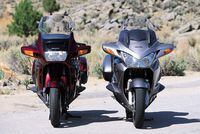Are Classic Sport-Touring Motorcycles Dead?
Is the classic sport-touring motorcycle doomed to extinction?

Adaptation is critical to the survival of any species. Scientists say the woolly mammoth drew its last breath around 10,000 years ago because it simply couldn’t get with the times; the days were getting warmer, and spear-wielding primates with no concept of contraception were multiplying about as fast as you’d expect.
Sport-touring motorcycles are going through a similar moment.
Or that’s how it looks on the surface, at any rate. The sport-tourer of yesteryear (that big, comfy battleship with a fairing like an ocean liner and an engine like a locomotive) is truly in its final days, but the news isn’t all bad. Sport-touring itself has never been better, and the new brood of go-fast, go-far machinery has never been more appealing.
Related: Best Fast Adventure-Touring Bikes
So why have so many models gone extinct over the last decade, and what sort of bikes have taken their place on the assembly line? Below I’ll go over why sport-tourers seem to be disappearing, and why the new school of versatility is a welcome change.
Who Killed the Sport-Tourer?
You know their names: Kawasaki Concours, Honda ST, Triumph Sprint… Each of these bikes were once titans of the showroom floor, but nowadays they’re all resigned to the annals of Facebook Marketplace.
These were all great motorcycles in their own right, but they all shared one common problem. None of them could keep up with the times.

Take the Kawasaki, for example. The Concours name had been in the Kawasaki lineup since 1986, then one day after four decades of loyal service, Big Green decided it wasn’t worth updating anymore and quietly moved on.
Related: Kawasaki Concours 14 ABS First Ride
Was its 673-pound weight too heavy? Was its 40-inch width too massive? According to the folks who bought them, neither size nor weight were issues worth mentioning.
In fact, specs like that were par for the course, and the same could be said for the Connie’s competitors like the aforementioned Honda ST or Yamaha’s FJR. So who’s to blame here?
Did OEMs pull the plug too soon? Did emissions regulations squeeze the life out of them? Or did you and I kill them ourselves through financial neglect?

The only honest answer here is natural selection: When given a wide selection of more capable, more versatile, and more appealing alternatives, it’s only natural that we as motorcyclists choose to spend our money elsewhere.
Wax romantic if you must about a bygone era of sport-tourers, but the simple fact remains that these bikes only ever did three things well: They were comfortable for two people and their luggage, went reasonably fast in a straight line, and handled reasonably well on a curvy road.
In retrospect, the bar looks awfully low. Why settle for “reasonably fast” when you can have a factory supercharger and turn 10-second quarter-miles? Why settle for paved roads when you can add dirt to the menu at no extra charge? Why settle for a 700-pound bike that needs a reverse gear when there’s a middleweight alternative that’s faster, lighter, and better looking?

Sport-touring rigs have changed so dramatically over the last few years that many riders no longer recognize them for what they are. Here’s how to pick a modern sport-tourer out of a lineup if you’re looking to go far and go fast in equal measure.
The Tall-Rounder

If you’re looking for the quintessential modern sport-touring motorcycle, chances are it’s currently filed in the “adventure/adventure-adjacent” section. Take all the things we look for in a good sport-touring bike (ample power, great handling, comfort, wind protection, etc.) then add longer-travel suspension, and you’ve got yourself a tall-rounder.
Related: BMW S1000XR Goes to the Track
The primary differentiator between an all-terrain adventure bike and a good sport-touring candidate is the front wheel. If good street manners are your top priority, chances are you’ll want to stick with a standard 17-inch front. A few of my favorite candidates in this space would be BMW’s S 1000 XR, Ducati’s Multistrada V4 Pikes Peak, or Kawasaki’s Versys 1000.

If you’re interested in the added versatility of some off-road action, a 19-inch front wheel strikes a solid compromise between sporty handling and unpaved potential. Most of the bikes in this genre fall under the 19-inch umbrella so I won’t even attempt to list them all, but I’ve had great experiences with the Africa Twin Adventure Sport ES, Triumph Tiger 1200 GT, and KTM Super Adventure S, just to name a few.
Related: 2024 Ducati Multistrada Pikes Peak
As the name suggests, tall-rounders are typically the sport-tourers of choice for taller riders who benefit the most from a little extra legroom and don’t mind a higher seat. These machines may look radically different from conventional sport-tourers, but in my experience even those sporting 19-inch front wheels deliver downright shocking performance on a twisty road, so don’t rule them out of your search.
The Superbike Weekender

If you’ve ever had a passenger on a superbike like Honda’s Fireblade or Yamaha’s R1, chances are you’ve heard a few complaints from your pillion in the comfort department. My favorite to date is probably “It feels like I’ve been sitting on a credit card for the last three hours.”
I’ve done my fair share of long-distance travel on a literbike, and comfort, range, wind protection, and storage are all abysmally lacking. Luckily you’ve got a few options out there that split the difference between an open-class racebike and an overnight traveler quite handily.

Take Kawasaki’s Ninja H2 SX SE, for example. The Kawasaki sport-touring formula used to be to take the most powerful engine in its lineup (most recently that was a ZX-14 donor), and then build a more touring-friendly package around it. The H2 follows the Concours tradition in that regard, but now we’re talking about throwing hard bags on a 998cc motor with a supercharger, which is hilariously entertaining, undeniably sexier, and keeps the total weight of the bike under 600 pounds to boot.
If you like the sound of something that’s truly sportbike-inspired but a bit more reasonable, Kawasaki’s Ninja 1000SX delivers a similar experience for a lot less money, hard bags and all. The same could be said for Suzuki’s GSX-S1000GT+, which actually employs the tried-and-true engine from the K5 GSX-R1000 along with comfortable ergonomics and room to store two full-face helmets.
The Middleweight Contender

There’s no denying the middleweight motorcycle is having a heyday. OEMs coax impressive performance numbers out of sub-1,000cc engines nowadays, making the massive powerplants (and proportions) of traditional sport-tourers feel more obsolete than ever.
Take one of my favorite examples, the current Yamaha Tracer 9 GT+, for instance. Yamaha is able to produce a claimed 108 hp and 63 lb.-ft. of torque with a 890cc triple, and that’s on a bike that weighs just 492 pounds fully fueled and ready to ride. That lightweight build also provides more tech and refinement than many open-class sport-touring rigs including electronic suspension, radar-linked cruise control and braking, a bidirectional quickshifter, and a six-axis IMU, so both performance and luxury are on offer here.

Other good examples include the MV Agusta Turismo Veloce, KTM’s 890 SMT, or the Ducati Multistrada V2, all of which deliver over 100 hp while keeping their wet weight under 500 pounds. These bikes may lack the sheer torque of larger-displacement engines, but they also have a 100-plus pound weight advantage over traditional sport-tourers, so neither passing power nor two-up performance is an issue.
Final Thoughts

I was riding a borrowed Honda ST1100 recently that put all this into perspective. It was a late-’90s model that had been nicely farkled by the previous owner, and was well on its way to 50,000 problem-free miles. The fact that it’s still running and riding as good as it did the day it left the factory is impressive, but it’s also a stark reminder of what’s wrong with the outgoing ethos on what a sport-touring motorcycle should be.
It’s hard to call any bike weighing over 600 pounds “sporty” by today’s standards. Will it eat up a cross-country trip in sublime comfort? Absolutely, but so will a Gold Wing. Is it the kind of bike I really want to ride on a twisty road? Not really, and until recently that was always the trade-off with a sport-tourer.
Holdovers like the current BMW R 1250 RT and Yamaha FJR deserve what fanfare they have left, but their appeal is aging out for a reason. If you want sporty performance and long-range comfort in equal measure, it’s time to adapt to the changing climate.

